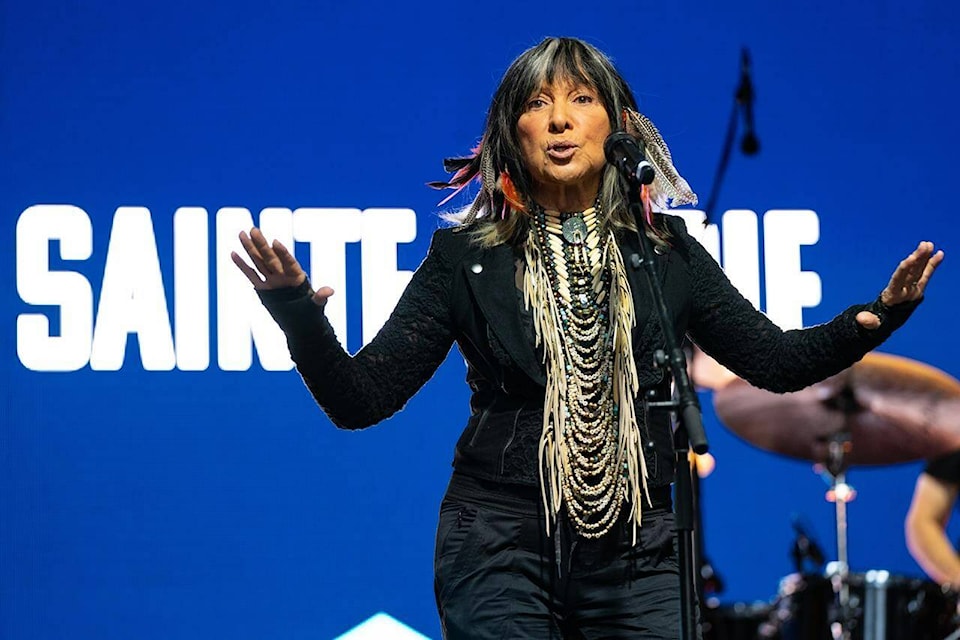Buffy Sainte-Marie has had enough.
Coming off a difficult summer that included a bout of COVID-19, the acclaimed singer-songwriter’s usually optimistic tone is undercut by a sense of frustration.
Over the past few months, on at least two instances, she’s been among the many airline passengers left stranded by a Canadian airline. One time, she was stuck at an airport for three days as delays and flight cancellations dragged on.
‚ÄúThe airlines are broken,‚ÄĚ she says while sitting in a Toronto hotel.
‚ÄúWestJet abandoned me. Air Canada abandoned me. Badly.‚ÄĚ
Sainte-Marie says she‚Äôs ‚Äúnot trying to cast blame,‚ÄĚ but as far as she‚Äôs concerned there‚Äôs no frequent flying in her future, which means far fewer concerts and appearances. She lives in Hawaii and the jet lag from flying to the mainland has become too much to bear, even without the prospects of being stuck in an airport.
‚ÄúIf I was 21, maybe I would, but I‚Äôm 81 and I deserve better, and I‚Äôm going to give it to myself,‚ÄĚ she adds.
A tribute concert set for Ottawa‚Äôs National Arts Centre on Friday and Sainte-Marie performance booked in Vancouver on Sunday are part of what she says is ‚Äúprobably going to be my last tour.‚ÄĚ
‚ÄúI‚Äôm not saying that I‚Äôm never going to perform again. It‚Äôs not like: ‚ÄėShe‚Äôs going to retire.‚Äô I‚Äôm not in the business world. I‚Äôve retired many times without ever calling it retirement,‚ÄĚ she insists.
‚ÄúI‚Äôm just going to hang it up.‚ÄĚ
Knowing that context, it‚Äôs easy to see ‚ÄúBuffy Sainte-Marie: Carry It On‚ÄĚ as the final word on the acclaimed Cree artist‚Äôs legacy.
The career-spanning documentary, which made its premiere at the Toronto International Film Festival earlier this month, plays at various other Canadian film festivals throughout September before its streaming debut on Crave in October.
Using interviews with Sainte-Marie, as well as contemporaries Joni Mitchell, Alanis Obomsawin, Robbie Robertson and others, the feature-length film profiles an artist and activist who was decades ahead of her time.
Stories reflect on Sainte-Marie’s roots in Qu’Appelle Valley, Sask. and her adoption by an American family from Massachusetts. When she was younger, she says people discouraged her from learning more about her Indigenous identity and pursuing a career in music, but eventually she fled to New York’s Greenwich Village to perform in coffee houses.
Sainte-Marie recalls how it felt to write and record anti-war anthem ‚ÄúUniversal Soldier‚ÄĚ only to see it become a hit through 1960s Scottish singer Donovan. And she details the painful history tied to winning a best original song Oscar for ‚ÄúUp Where We Belong‚ÄĚ which she co-wrote with her ex-husband Jack Nitzsche, whom she describes as abusive.
Lighter memories detail her cultural influence as a recurring guest on children‚Äôs program ‚ÄúSesame Street,‚ÄĚ where she breastfed her child on national television, and her foray into digital art in the 1990s.
While many of these stories have been told before in other documentaries and interviews, ‚ÄúCarry It On‚ÄĚ steps back farthest to put Sainte-Marie‚Äôs perseverance into a broader social context.
Telling her story from a new vantage point was important, she says.
At first, she wasn’t convinced the world needed another Sainte-Marie documentary when Toronto production company White Pine Films approached her with a rough pitch. She recoiled at the thought of being the subject of a rockumentary filled with musicians singing her praises.
‚ÄúSome documentaries are that old-style, boring thing and I‚Äôm not interested,‚ÄĚ she says.
‚ÄúIt just kind of sounded like scrapbooking.‚ÄĚ
As conversations with White Pine continued, Indigenous-led production house Eagle Vision got on board. They brought in Madison Thomas, a Winnipeg-based filmmaker who is Ojibwe-Saulteaux and Russian-Ukrainian, to help shape the idea.
Andrea Warner, author of Sainte-Marie‚Äôs 2018 authorized biography, was also added to the group as a co-writer, which Sainte-Marie says created a ‚Äúreal comfort zone‚ÄĚ to discuss how the film would take shape. The three women broke off from the production companies and held regular meetings over Zoom in the midst of the pandemic.
Their finished documentary arrives as more attention is put on making space for Indigenous creators in the Canadian film scene. Sainte-Marie hopes those conversations will extend to Hollywood as well.
She points to a recent apology to Sacheen Littlefeather by organizers at the Academy Awards as a sign of positive change.
Littlefeather became a target of hate when she was booed at the 1973 Oscars for refusing the best actor award on behalf of Marlon Brando. In her speech, she criticized Hollywood’s portrayal of Indigenous people and called for more attention to the standoff at Wounded Knee.
The Academy of Motion Picture Arts and Sciences recently sent a letter of apology to Littlefeater and will host an event this weekend in her honour.
‚ÄúI‚Äôm so glad they did,‚ÄĚ says Sainte-Marie, who is recognized in the newly minted Academy Museum of Motion Pictures in Los Angeles.
‚ÄúIn repairing their reputation they‚Äôre doing something that needed to be done for a long time,‚ÄĚ she added.
‚ÄúSo let‚Äôs applaud that and not carry a grudge.‚ÄĚ
Sainte-Marie says she hopes this is a sign of further efforts the Academy may take for Indigenous representation, particularly among its voting members.
Holding those optimistic hopes is what keeps her moving forward, she adds.
‚ÄúI seek out joy. I seek out good friends,‚ÄĚ she says.
‚ÄúAnd I have enough good food in my diet to survive just about any chocolate cupcake that comes along.‚ÄĚ
‚ÄĒDavid Friend, The Canadian Press



